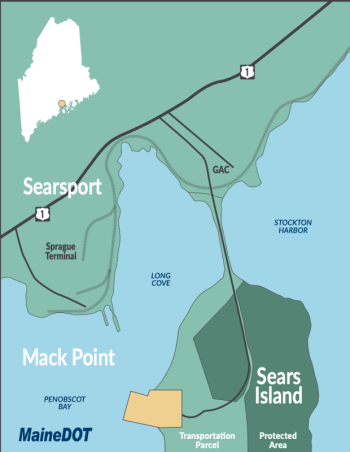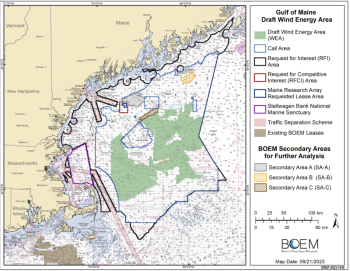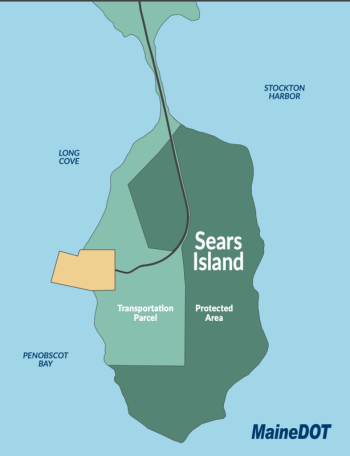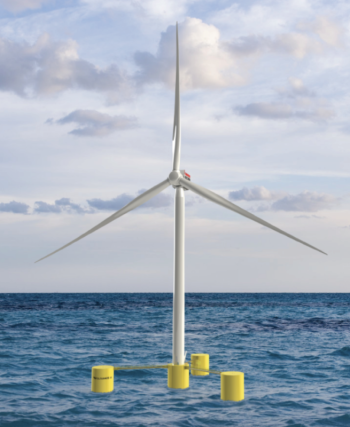Maine’s plan to site wind power port on Sears Island draws swift response, with support and opposition
SEARSPORT — The announcement made Feb. 20 by the State of Maine that is has chosen Sears Island and not Mack Point in Searsport as its preferred site for a port facility to support the floating offshore wind industry drew both praise and condemnation, as press releases and statements flowed in from a variety of stakeholders.
The Maine Dept. of Transportation is anticipated to apply for state and federal permits later this year.
Site selection for the port development, which began in earnest in 2020, had included the assessment not only of Searsport, but Eastport and Portland. In the end, it was the head of Penobscot Bay that rose to the top of the Maine Dept. of Transportation’s list.
“The State concluded that the Sears Island parcel is the most feasible port development site in terms of location, logistics, cost, and environmental impact based on input from port and offshore wind stakeholders, including the University of Maine, and on technical and engineering analyses,” said Gov. Mill’s office, in a news release.
The Maine AFL-CIO signaled support of the plan just moments after the state made its announcement, saying it applauded the DOT’s decision, “to recommend to the federal government that a new port be developed on state owned land on Sears Island for the development of offshore wind. “
But others, including an Alliance for Sears Island, also said immediately following the state’s announcement that it would hold a demonstration against the decision Wednesday, February 21, between 3 and 6 p.m. on the Belfast Bridge.
“The state of Maine wants to build an offshore wind manufacturing facility on Sears Island, breaking its promise to Maine residents to give preference to Mack Point,” wrote the nonprofit Upstream Watch. “Let MDOT and Governor Mills know that Maine can have offshore wind AND a wild and free Sears Island!”
Gov. Mills said in her news release: “This was not an easy decision, nor is it one that I made lightly. For more than two years, my Administration has evaluated Sears Island and Mack Point thoroughly and with an open mind, recognizing that each site has its own set of benefits and its own set of drawbacks. In carefully considering all of these, I believe that, on balance, Sears Island is the best choice for an offshore wind port because it is already owned by the state, designated for the purpose of port development, will cost less in the short-term and long-term, and is expected to result in less environmental harm.
“With that said, I recognize that the construction of a port is not insubstantial, and it will be a change to an area that is enjoyed by many people. I take these changes seriously, and I recognize their impact. However, in weighing the costs and benefits of both locations, I cannot escape the conclusion that the parcel on Sears Island fundamentally makes the most sense and provides us with the best opportunity to responsibly advance offshore wind in Maine, an industry that will create good paying jobs for Maine people and deliver clean, renewable energy to stabilize and reduce energy prices for Maine people and businesses in the long run.”
The 941-acre Sears Island sits across from the industrialized Mack Point, and both lie within the Town of Searsport. In 2009, Sears Island was divided into two parcels: approximately 601 acres was placed in a permanent conservation easement held by the Maine Coast Heritage Trust, while the remaining 330 acres was reserved by MaineDOT for future development.
The Governor’s release said the $500 million wind power project site on Sears Island is to be 100 acres, and where a new facility would be built for, “floating offshore wind fabrication, staging, assembly, maintenance, and deployment.”
The goal is to establish Maine as a wind power player, become part of the “blue economy,” and meet anticipated demand for offshore wind port infrastructure. The new blue economy is described as: “a knowledge-based economy, looking to the sea not just for extraction of material goods, but for data and information to address societal challenges and inspire their solutions,” said Richard Spinrad, Under Secretary of Commerce for Oceans and Atmosphere & NOAA Administrator, at NOAA’s blue economy webpage.
“Maine has a once-in-a-lifetime opportunity to help transform its economy and protect our environment by leveraging our North Atlantic winds, our maritime and manufacturing skills, and land reserved for port development to responsibly bring the multi-billion-dollar floating offshore wind industry to our doorstep,” said Bruce Van Note, Maine DOT Commissioner, in the release. “The decision to pursue port development on Sears Island is in the best interest of our state’s economy and our climate. I hope Maine seizes this opportunity.”
Unions like the idea of jobs, and expressed support for the project. But the AFL-CIO also cautioned against it potential effects on the lobster trade.
“The selection of Sears Island for a new offshore wind port will ensure there is ample space for the development of commercial wind turbines, while protecting valuable fishing grounds that fishing families depend on. Had the MDOT chosen Mack Point for the site, it would have required costly shoreline dredging and offshore disposal that would certainly have harmed water quality and marine habitats,” said Cynthia Phinney, President of the Maine AFL-CIO. “At the same time, developing a port of this size could have impacts on fisheries due to increased vessel traffic, widening of the federal navigation channel, noise and lighting, or alteration of the shoreline. It's critical that the state and federal governments ensure that commercial fishing organizations, including Maine Lobstering Union (IAM 207), continue to have a meaningful seat at the table throughout the port permitting and development process to ensure the best outcomes and so that fishermen are included in the negotiation of any community benefit agreements associated with this project.”
The University of Maine likes it because it can move ahead its design for a floating offshore wind research array in the Gulf of Maine.
Other organizations like it because it presents another port in Maine’s maritime infrastructure.
“The development of Maine’s port infrastructure is a cornerstone in realizing the economic dividends of an offshore wind industry and further expanding our international trade,” said Patrick Woodcock, President and CEO of the Maine State Chamber of Commerce, in the release. “There is an acute scarcity of unobstructed deepwater access across the eastern seaboard, and Maine has the opportunity to develop a world-class facility and finally realize the vision of the state’s three-port strategy. The Maine State Chamber of Commerce supports the leadership of the Mills Administration in identifying this site and looks forward to engaging in the permitting process to develop this infrastructure.”
The Natural Resources Council of Maine issued its statement of support: “Building a port is a big deal, and we must do it right – choosing a site that balances our ability to grow this source of renewable energy at the scale we need, while minimizing environmental impacts and maximizing community benefits,” said Jack Shapiro
NRCM Climate and Clean Energy Director, in a public letter from NRCM. “Today’s announcement is an important first step in an extensive process of federal and state review, including many opportunities for public input.... This port will generate good-paying jobs and family-sustaining careers, economic investment in the region, and open the door to our success in addressing climate change.”
And the Maine Conservation of Voters likewise issued support for wind power, and advocated for maintaining a seat at the decision-making table.
“To meet and surpass our ambitious climate goals, we need to take advantage of the clean energy resources right here in Maine,” said Beth Ahearn, Director of Government Affairs of Maine Conservation Voters and cochair of the Offshore Wind Port Advisory Group. “Offshore wind will be essential to our transition away from expensive and dirty fossil fuels, and to realize this incredible opportunity, we need port infrastructure. Today’s announcement of Sears Island as the preferred port location builds on the undeniable momentum of this new industry and is based on responsible, thorough, and comprehensive research. Maine Conservation Voters has and will continue to be an active participant and will do our part to ensure the new port has the least impact to – and most benefits for – the environment and local communities.”
Maine crafted its Offshore Wind Roadmap, released one year ago, and said a, “port facility is a priority for unlocking Maine’s opportunity in offshore wind to create good-paying jobs, spurring broad economic development, and generating abundant clean electricity to stabilize energy costs and reduce reliance on fossil fuels.”
Searsport Town Manager James Gillway said the town regards: “the construction of a floating offshore wind port as a modern-day continuation of that vessel-building tradition. I am pleased that four years of hard work and public engagement have resulted in today’s selection of a wind port location. This decision keeps the ball rolling and moves us much closer to the State’s goals. I look forward to working with the governor’s office and MaineDOT to build a state-of-the-art port facility that is environmentally friendly and mitigating the impacts of this development on the local community and environment.”
Sears Island over Mack Point
According to the Governor’s news release, a study delivered in November 2021 evaluated various locations in the Port of Searsport for an offshore wind port, including Mack Point and Sears Island.
In March 2022, MaineDOT announced the creation of a 19-member Offshore Wind Port Advisory Group to advise the State on port development. The Group, which included a broad spectrum of state and local stakeholders, held six public meetings in 2022 and 2023 and toured existing port facilities in Searsport and Eastport to inform its work.
The following factors support State’s selection of the Sears Island site:
- The State of Maine owns the parcel of land on Sears Island;
- The parcel of land on Sears Island has been reserved since 2009 for development;
- As a large, level area with deepwater access, the Sears Island site has beneficial physical and logistical characteristics for building a port facility at the scale required to support floating offshore wind port operations;
- Unlike adjacent Mack Point, the Sears Island site is not expected to require dredging, a key environmental and financial consideration for a port project;
- The Sears Island site would avoid impacts on existing commercial or industrial activities in the Port of Searsport;
- Because the parcel of land on Sears Island is owned by the State, the upfront and ongoing costs for a port facility are estimated to be substantially less than on Mack Point, which is privately owned and would require monthly lease fees.
- The estimated port construction cost on the Sears Island site is approximately $500 million. The State is seeking funding opportunities for the port, such as from Federal sources expanded under the Bipartisan Infrastructure Law, which recently awarded funds to support a floating offshore wind port in California.
- The port proposal is subject to extensive and independent state and federal permitting processes, including assessments of environmental impacts and alternative sites. MaineDOT, on behalf of the State, intends to apply for permits later this year, which will also include additional opportunities for stakeholder and public input on the project.
In July 2023, Governor Mills signed LD 1895, legislation to advance offshore wind in Maine by procuring up to 3,000 MW of offshore wind energy.
According to the Governor’s office, Maine has proposed to lease a site in federal waters of the Gulf of Maine for a Floating Offshore Wind Research Array. An application for that lease site remains pending before the Bureau of Ocean Energy Management.
The array is proposed to include 10–12 turbines on semi-submersible floating concrete platforms known as VolturnUS, designed by the University of Maine’s Advanced Structures and Composite Center. The final size and location of the research site will be determined by BOEM during its leasing review process.
In January 2023, BOEM released its draft area for potential commercial offshore wind leasing in the Gulf of Maine. In November, Governor Mills joined Maine’s Congressional Delegation to request Lobster Management Area 1, a highly productive fishing ground, be excluded from offshore wind siting maps.
“As this process unfolds, Governor Mills continues to press the U.S. Department of the Interior, which oversees BOEM, to involve Maine fishermen in federal plans for leasing in the Gulf of Maine for commercial offshore wind,” the release said.
“To preserve State waters for recreation and fishing and cement into law Maine’s priority of locating offshore wind projects in federal waters in the Gulf of Maine, Governor Mills in 2021 signed LD 1619, which prohibits new offshore wind projects in State waters.
“Other offshore wind initiatives include the Maine Offshore Wind Research Consortium, an assembly of fisheries, wildlife, and marine science and industry experts advising the State’s offshore wind research; and advocating for Maine’s interests in federal plans for commercial offshore wind leasing through the Gulf of Maine Task Force.”




























